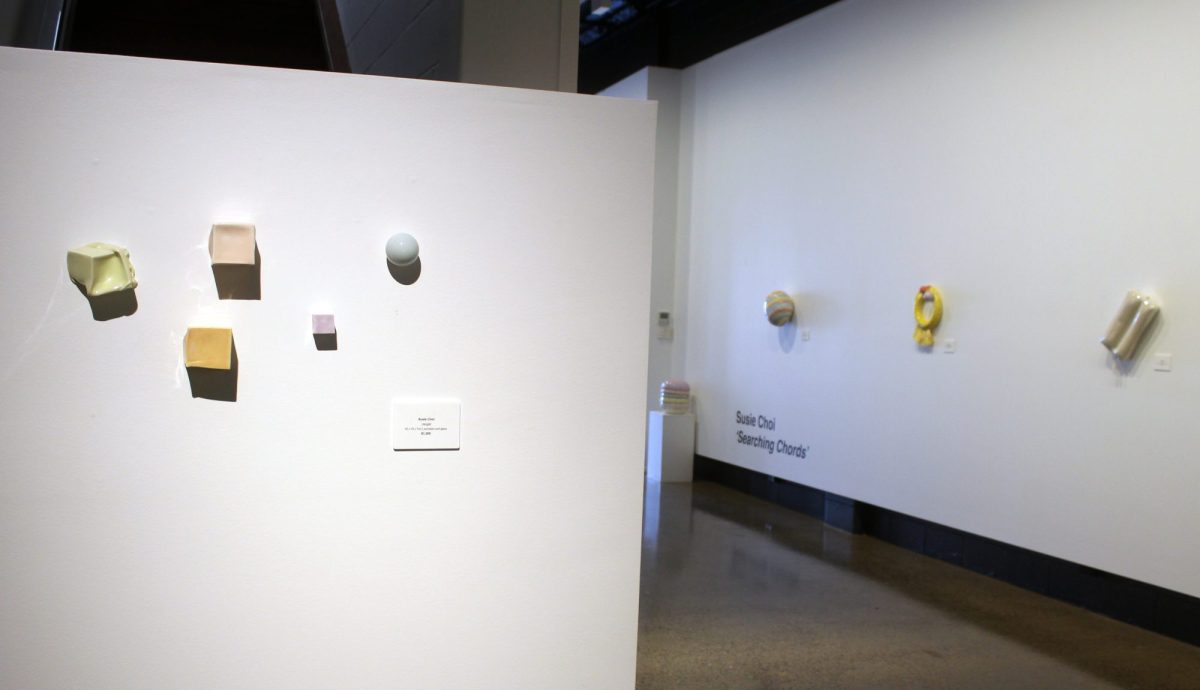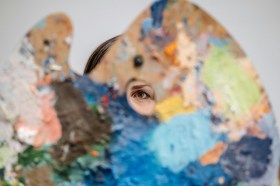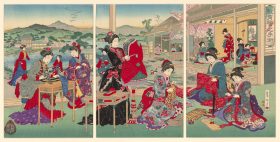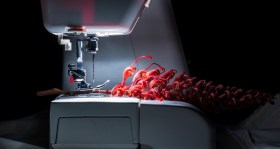The introspective porcelain slip-cast sculptures in Susie Choi’s Searching Chords at Mitchell Fine Art may resonate with myriad demographics across the cultural milieu. The experimental body of artwork draws on her memories as a child of Korean migrants, who grew up in Sydney during the 1980s and 1990s.
She builds on the principles of autoethnography, which burgeoned during this time. Ownership of the symbols is offered up to viewers. Her ceramic creations are thereby transformed into repositories of their memories, imaginings and, ultimately, identities. This is achieved without the expense of sharing her own story.
Carriage of multiple connotations
Union (2024) primarily consists of a porcelain slip-cast toddler-sized inflatable “swim ring”. Two intercepting sets of saekdong patterns, which vary in hues, occupy an unglazed surface. One is in traditional high saturation and the other in contemporary pastels. Tassels, another Korean textile device for attracting good luck, dangle from its centre. There is a depression in the top left of the replica, which reflects the plasticity of its original. The capacity of mould-making, to capture a moment, is also emphasised.
A reading by the child of an Asian migrant could be of an inculturation failure. In social situations, you either sink or swim. The buoyancy of a plastic inflatable doesn’t translate into porcelain. However, other children growing up in the 1980s may be reminded of analogue television: a strip of rainbow colours featured on the Australian Broadcasting Corporation’s “test pattern” screen. Equally, the colours could give a teenager of the 1990s cause to recall using Polaroid cameras. The film packaging was similarly striped. There would be little ambiguity of the connotations carried by rainbow patterns for Generation Alpha. Since the mid-2010s, the stripes have become inextricable from the LGBTQIA+ communities.
Encapsulating Y to Alpha
Becoming a mother to two Alphas appears to have catalysed Choi’s contemplation upon her own upbringing. The abundance of toys undoubtedly fuelled its material reconstruction.
Balls can be the bane of a parent, which could be encapsulated by When the Wind Changed (2024). A rubber handball specimen is embedded into its porcelain pool ring, like one angry eye. A slip-cast version of a squishable air-filled variety, like the ones that occupy ball pits, makes an appearance in Colosseum (2024).
Helium-filled mylar party balloons constitute a third element of childhood, with a currency spanning from Generations Y to Alpha. Percussion (2024) and Chorus (2024) are suspended and wall-mounted respectively.
Giving the cultural identity debate appropriate gravitas
Executing each of these complex compositions required considerable expertise. Moulds were made of the sourced objects. After slip-casting, some were repaired and others imperfected. In addition to her skills in ceramics, Choi leans into her vast knowledge of linguistics. Many of the artworks have lyrical yet laconic titles, such as Drawl (2024) and Diphtong (2024). A speaker of another language learning English may attest to the difficulties of trying to pronounce the Australian variation.
Another issue the artist has explicitly foregrounded is the rigid expectations Asian communities place on their members. These include having to academically perform and maintain politeness. These ceramic casts of inflatables are as much about pressure as they are plasticity. Ruptures and kinks, left or deliberately fashioned, leave some artworks, like Busted (2024), open for less proper interpretation.
Read: Exhibition review: Candice Lin: The Sex Life of Stone, MUMA
Playful, and at times naughty, but never prescriptive
Like a bag of “all sorts” confectionery, this is an exhibition that arguably has elements to delight audiences of all ages. Its reach extends beyond the communities represented by the artist’s intersectionality. She delivers to viewers seeking stories about her struggles with identity. The slip-casting process produces hollow objects. Choi has similarly left conceptual caveats for contemplation. Viewers are offered space to bring or create their own narratives. This understatement of her own voice, to give rise to a chorus of viewer interpretations, makes the artwork defining of its time.
Searching Chords: Susie Choi will be exhibited at Mitchell Fine Art until 31 August 2024.





